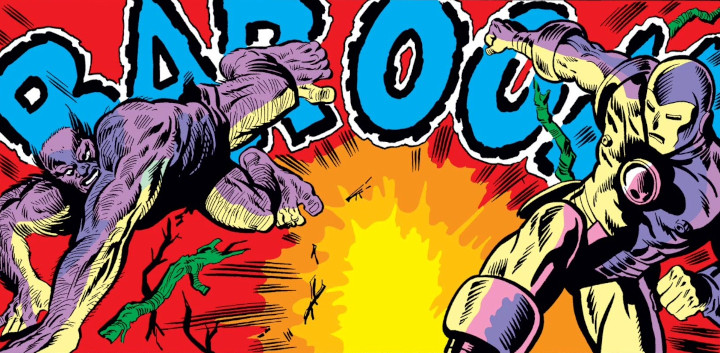
I recently had this crazy idea: I decided I would attempt to read the X-Men comics from the very, very beginning, then see how far I could get before I got completely burned out on X-stuff. I’m now chronicling the second phase of that journey, the so-called “Hidden Years.”
In case you’re unfamiliar, the “Hidden Years” were the five-year period when the X-Men didn’t have their own book (it got cancelled in 1970), but the characters still had storylines that weaved through other books, such as Avengers, Incredible Hulk, and Captain America.
(Note that the first phase of this reading journey was the 1960s era, which took me right up to the series cancellation in 1970. I wrote about that in my previous X-Men review.)
X-Men “Hidden Years” reading order
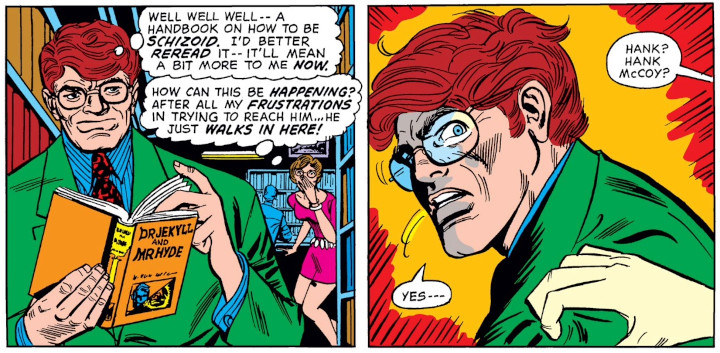
I’m going to post the reading order first, in case that’s what you’re here for (and the review is pretty hefty). This is mostly a modified version of the the incredible Crushing Krisis reading order, but I also shoveled some of this together based on the It’s Always Darkest Before the Dawn Epic Collection and the in-panel cues within the stories themselves. Note that this is how I chose to read this run personally, and I’ve added quite a few things to it that aren’t really essential. I’ll have explanations about what those issues are in the review below.
If you’re reading through this yourself, you’ll probably want to add Fantastic Four (1961) #102-104 to the start of this list, but I’d already read that as part of the previous run (since F4 #102 follows the Magneto story in Uncanny X-Men #63).
- Avengers (1963) – #88
- Incredible Hulk (1962) – #140
- Amazing Adventures (1970) – #9-11
- Incredible Hulk (1962) – #150
- Amazing Spider-Man (1963) – #92
- Amazing Adventures (1970) – #12-14
- Marvel Team-Up (1972) – #4
- Amazing Adventures (1970) – #15-17
- Incredible Hulk (1962) – #161
- Avengers (1963) – #102-110
- Daredevil (1964) #99
- Avengers (1963) #111
- Incredible Hulk (1962) – #172-174
- Adventure into Fear (1970) – #20
- Captain America (1968) – #172-175
- Marvel Team-Up (1972) – #23
- Defenders (1972) – #15-16
- Captain America (1968) – #183
- Incredible Hulk (1962) – #180-182
- Avengers (1963) – #137-144
- Marvel Team-Up (1972) – #38
- Giant-Size Fantastic Four (1974) – #4
This list looks pretty intimidating, but it ends up being 51 issues, if my math is correct. That means this chunk of comics is just over half the size of the 1960s run (in the reading order I laid out in my previous review, I read all 66 issues of Uncanny X-Men, plus 20 additional issues from other series — this means I’m up to 137 issues so far, which is no small reading assignment). This run feels less tedious than the 1960s issues, because Marvel’s storytelling has improved quite a bit by this point in history.
Also, this mapping is really close to the perfect size for an omnibus, though you’d probably snip down some of the Avengers issues, which aren’t really necessary. I’m guessing such an omnibus would sell just fine, considering used copies of It’s Always Darkest Before the Dawn sell on Amazon for over $700. Just sayin’, Marvel… just sayin’.
Spoiler alert
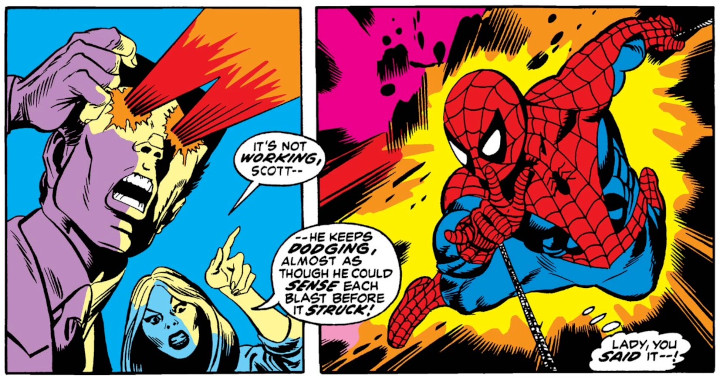
If you don’t want this era of X-Men spoiled for you, you’ll probably want to turn away now. This material is really hard to find if you’re into physical media (if you’re a Marvel Unlimited subscriber, it’s pretty easy to read all of this digitally), and it was published five decades ago. Both of these facts seem like solid justification for talking about this in a spoilery way.
So this is your last warning. If you don’t want early-1970s X-Men spoilers, then turn back now. You can always come back later when you’ve read all this stuff.
So, how is it?
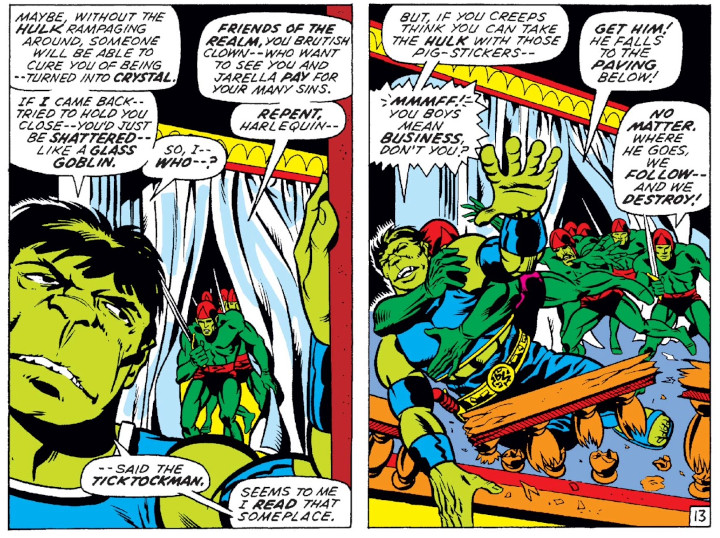
So, I started with a two-part story that begins in Avengers #88 and leaps into Incredible Hulk #140. This story is completely optional (it has just a brief appearance by Charles Xavier at the beginning), but it’s well worth reading because it was plotted by science-fiction legend Harlan Ellison.
Aside from giving the Marvel crew excuses to cram in as many Harlan Ellison references as possible, this also gave them a pretty incredible story arc to play with. A lot happens in these two issues, so I won’t break it all down, but Hulk ends up shrunken down in a world filled with tiny green people. A magic spell gives him the mind of Bruce Banner in the body of the Hulk. Because everyone’s green, he fits in, and because he slayed a mighty beast (a weird cross between a boar and a dog), he was set marry Queen Jarella (who is also green) and become king of this realm.
But alas, it was not meant to be, as Psyklop (the villain of the story) quite literally plucks Hulk from this world, grows him back to normal size, and turns him back into the less-scholarly version of himself. Hulk does retain fragments of the memory of this place, though — only to remind him that he once had a chance at a pretty happy life in a world made for creatures like him, and that it was all taken away from him.
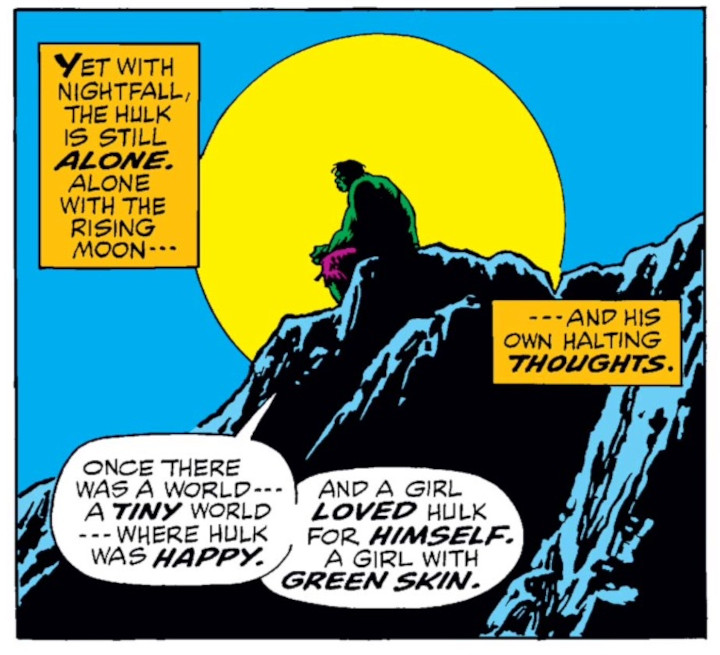
Even though this is completely optional (and this story isn’t included in It’s Always Darkest Before the Dawn), I do recommend reading it, because it’s such a good thematic build into the Beast arc in Amazing Adventures. Bruce Banner and Hank McCoy have a lot in common: Both are geniuses trapped in the body of a beast, and both of them live with a lot of tragedy.
And speaking of tragedy, I was not expecting Beast’s transformation from human-with-big-feet to furry-dude to be so heartbreaking. He basically turns himself into beast form temporarily, knowing he can undo it so long as he doesn’t remain a beast for too long. But while in beast form, his beastly instincts take over and he forgets to watch the clock. When he finally remembers he was supposed to turn himself back, it’s too late. In beast form he must remain forever.
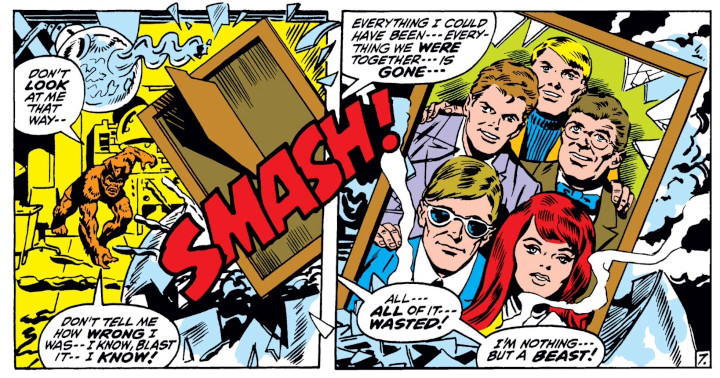
This is even more tragic because his life was actually going really well. He had an important government job as a researcher into mutant biology, and he was starting to date a new flame, Linda (more on her later). But Beast’s transformation pretty much puts and end to those things. He does fashion himself a rubber suit that he can disguise himself with, but this is something we can see quickly unraveling as his double life becomes harder and harder to sustain.
I’ve loved Beast for as long as I’ve been reading X-Men, but this story really solidifies him as a top-tier Marvel character for me. I admit, I love the sadder storylines, and the two I’ve mentioned so far are some real downers.
Before I move past Beast’s arc in Amazing Adventures, I should point out here that issue #17 is mostly just a reprint of Beast’s origin from the original run of X-Men. This is a collection of the B stories from Uncanny X-Men (1963) #49-53, with a few establishing and concluding panels thrown in to frame the whole thing. If you’ve read all of the 1960s X-Men (like I have), then this issue is completely skippable. And even if you haven’t, these stories were never all that compelling in the first place. That is to say, if you skipped reading the 1960s X-Men because you’re just not interested in it, then you can also skip Amazing Adventures #17 because you’re probably not interested in that either.
If you’re wanting to follow Vera’s Canada story (from issue #16), however, that continues in Incredible Hulk (1962) #161.
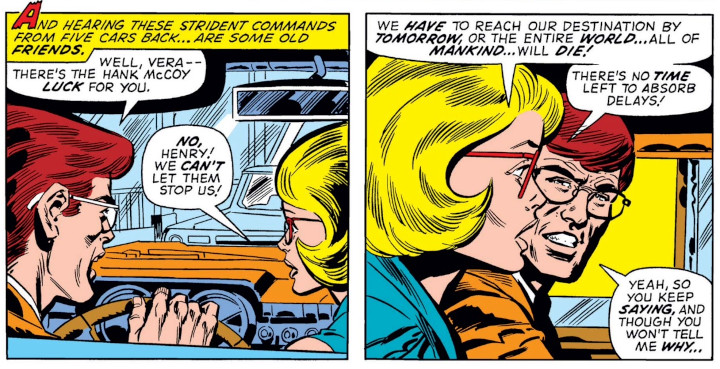
This issue brings back Calvin Rankin (A.K.A. the Mimic), who you might remember from Uncanny X-Men (I believe his last appearance before this was in issue #29). He’s getting a deadly version of his power back, where he drains the lifeforce from anyone who gets near him. Realizing that anyone in his vicinity is in danger, he secludes himself in a cabin somewhere in the frozen wilds of Canada.
Vera had specifically sought out Hank McCoy to help her deal with Rankin’s powers (Calvin and Vera had been dating), but our rubber-mask-wearing friend Hank is unable to do anything in time. Our other big, sad friend, Hulk, sensing his own powers being sapped from him, follows the trail and smashes into the cabin, where his gamma radiation is absorbed by Rankin. Rankin accepts that this will kill him, saving humanity from his powers once and for all.
And so concludes yet another tragic tale from the “Hidden Years,” as well as Beast’s story for now (he’ll eventually end up in the Avengers).
And speaking of the Avengers, I decided to read a pretty decent chunk of that series at this point, beginning with the appearance of the Sentinels in issues #102-104, right up through the conclusion of the Magneto story in issues #110-111. The middle section isn’t required reading, and really, neither is the Sentinels story, but I was interested in following the team for a while regardless. Honestly, I was hoping to see Beast join the team and I wasn’t sure which issue that would be (as it turns out, that arc doesn’t begin until issue #137… oops).
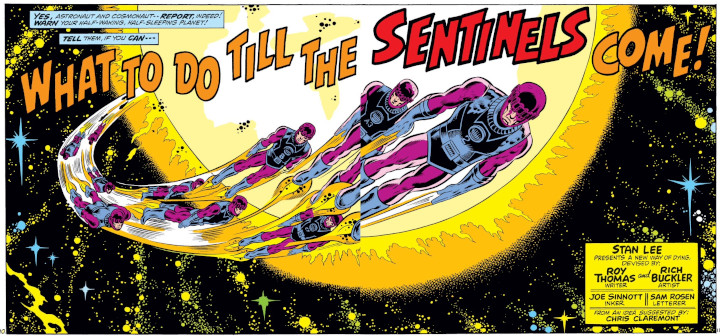
As for this Sentinel story… it’s completely absurd. The Sentinels return from their trip around the sun (which began back in Uncanny X-Men issue #59), and they now have a really strange idea about how to protect humanity from the mutants. They decide that they’re going to trigger a solar flare, which will sterilize all humans. Then, when humans eventually die off, the Sentinels will create a fresh batch of them, genetically modified to prevent mutation. So this lets them wipe out all mutants (and all potential future mutants) without killing a single human.
However, it’s eventually revealed that the lead Sentinel is also a mutant — apparently the trip around the sun caused it to mutate somehow — and the other Sentinels destroy it. When their leader is destroyed, they all just kind of shut down, and one of them falls right on top of Larry Trask, killing him. Larry Trask, for those who didn’t read the 1960s X-Men run, was the son of Bolivar Trask, who created the Sentinels. Yeah, this is one weird sequence of dominoes…
And when all that business is through, Captain America leaves us with some classic Steve Rogers words of wisdom.
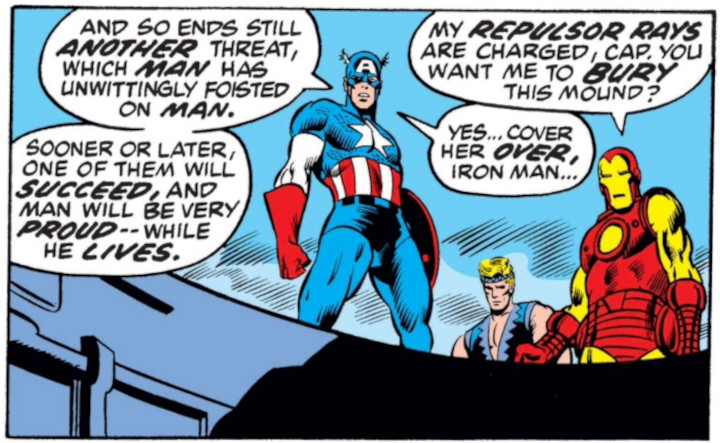
Now, I think it’s a little strange that a lot of “Hidden Years” reading lists leave out Avengers issue #105. This story is actually a follow-up to Uncanny X-Men issue #63, and while the X-Men aren’t present, they’re mentioned a whole lot. Plus, the upcoming battle with Magneto is teased (which will finally happen in Avengers #110-111).
But before Magneto’s return, we get a bunch of memory-wipe stuff from Cap and the beginning of the romance between Wanda and Vision (which is more relevant than ever nowadays). Oh, and a nine-foot-tall dude tricks Hawkeye into teaching him archery so he can use a bow and arrow to trigger a bomb that will cause California to sink into the ocean. No, I’m not joking…
This chunk of comics (Avengers #106-109) was worth checking out to see the Grim Reaper/Vision story arc to its conclusion, but I would hardly call it required reading. It pulls a lot of storylines from other ongoing series (from Captain America to Thor to Fantastic Four), and this current reading list is already pretty bloated so I’m not going to read any of that stuff right now. The MCU really does have some of this same storytelling energy, doesn’t it?
But I’m just here for the X-Men, so it was good to finally find out what they’ve been up to. It turns out, they’d been dealing with Magneto, who stole Angel’s costume and left the rest of the team comatose in a banged-up mansion. Yeah, Magneto can now manipulate the iron in the blood of mutants to render them unconscious. Oh, and there’s a dude called the Piper who can summon dinosaurs. Apparently, he was one of the mutants that Magneto “made” (which we learned about back in Uncanny X-Men #63), but I don’t remember him being among the “Mutates” there. (I went back and checked, and it turns out Piper was briefly mentioned in Uncanny X-Men #62).
Piper will go on to join the Morlocks later on in the series, so this isn’t the last we’ll see of the flautist. (Weirdly, the Marvel database for Piper doesn’t mention anything about his origins, saying “Virtually nothing is known about the life of the man known only as Piper before he came to join the underground community of mutants known as the Morlocks,” which leads me to believe his origin as one of Magneto’s “Mutates” was retconned by the 1980s).
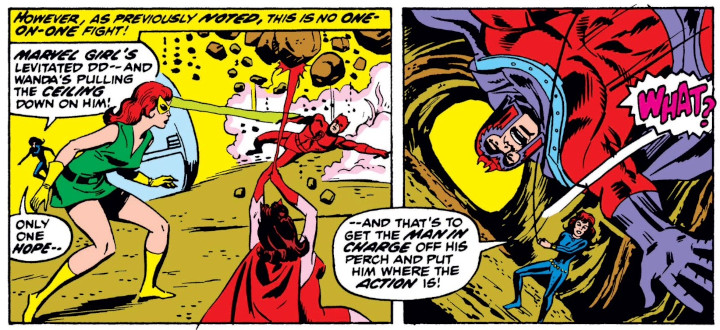
The in-panel notes suggest that you read Daredevil #99 between Avengers #110 and #111, but it’s really unnecessary. It’s basically Hawkeye being a complete ass for an entire issue. There’s a scene where Daredevil and Black Widow are recruited to help out in the fight against Magneto, but this scene pops up in a flashback in Avengers #111 anyway.
From here, I hopped over to Incredible Hulk (1962) #172, which is Juggernaut’s next appearance after his battle with Beast in Amazing Adventures #16. The X-Men make some very brief appearances here as well to remind the audience that they still haven’t found Angel yet.
Incredible Hulk #173 and #174 usually don’t get put on reading orders for this era, but I added those issues because they deal with the Cobalt Man, last seen in Uncanny X-Men issue #31. This continues his story, so if you were curious about what happens to him, this is where you’ll find out.
Now, Captain America #172 is a kind of ridiculous story where Banshee is on his way to a Merle Haggard concert and ends up thinking Cap is attacking him. The X-Men show up at the end and Professor Xavier suggests that they are hunting the same enemy — no, not Banshee, but a group called the Secret Empire. Over the next few issues, we’ll learn a whole lot more about them, and we’ll see how they have ties going back as far as Beast’s story. (Remember Hank’s girlfriend Linda? She’s a part of the Secret Empire.)
All of this was remarkably well set up, considering the payoff is an organization that chooses to remain secret, but also shows Cap and Falcon the secret entrance to their hideout with astonishingly little persuasion.
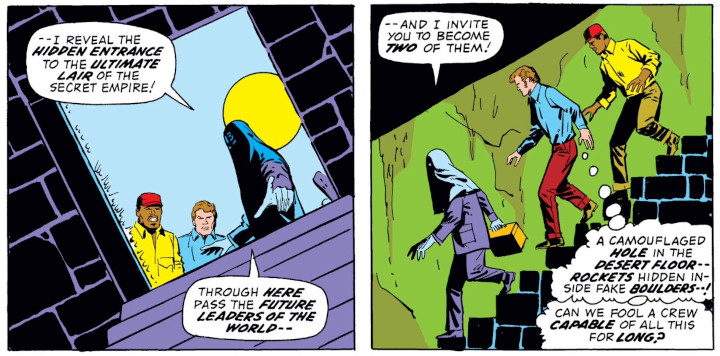
Of course, this was all a trap, and the idea was to lock Cap and Falcon in a room that would laser-beam them to death. But thankfully, Professor X is sending Falcon telepathic directions about how to escape. And escape they do, ultimately fighting the Secret Empire on the White House lawn.
After this, we get a team-up between Iceman and the Human Torch, as they take on a baddie called Equinox, A.K.A. the Thermodynamic Man. When I looked at Equinox’s Wiki page, I realized I’ve actually read some other stuff where he’d had a role, namely Civil War. The fact that I don’t remember him says probably everything that needs to be said about him.
One of the most critical storylines of this era is also one of the most absurd. In the pages of Defenders #15-16, we see Magneto’s mutant-making power at full force, as he creates a being called Alpha. It’s not completely clear what Alpha’s mutant power is exactly, because he kind of just does a little of everything. He’s portrayed as something of a demigod here.
As the story progresses, Alpha’s head expands until it’s this massive lightbulb-shaped oddity. He wants to side with good and against evil, so the X-Men have to convince him that Magneto is evil (which really shouldn’t be hard, considering Magneto leads a group called the Brotherhood of Evil Mutants).
At the end of this story, Alpha turns everyone in the Brotherhood into a baby, then basically says “Peace out” and flies off into space. If you’ve read the early part of Claremont’s run and wondered why Magneto starts out as a baby, this is why. (Magneto will eventually be back to his adult self, but he’ll be in baby form for a good long while first.)
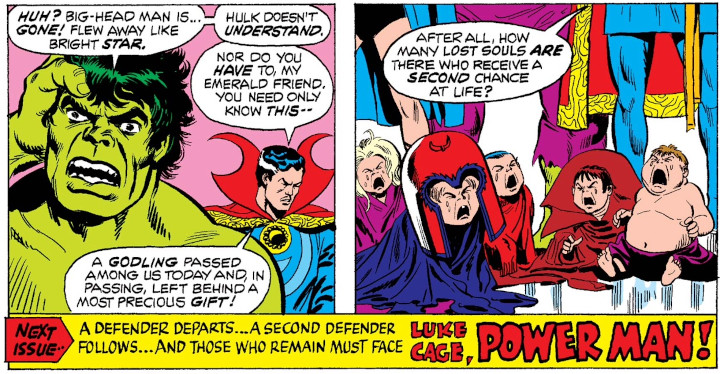
From here, we jump into Wolverine’s first appearance, which happens in the pages of Incredible Hulk #180-182. I do have to warn folks who are interested in this era that this arc didn’t age well, and that issue #182 is genuinely heartbreaking.
Plus, Wolverine looks super weird here. If this was your introduction to the character, then it probably came as a surprise to see him become such a popular character later on. I mean, just look at this guy:
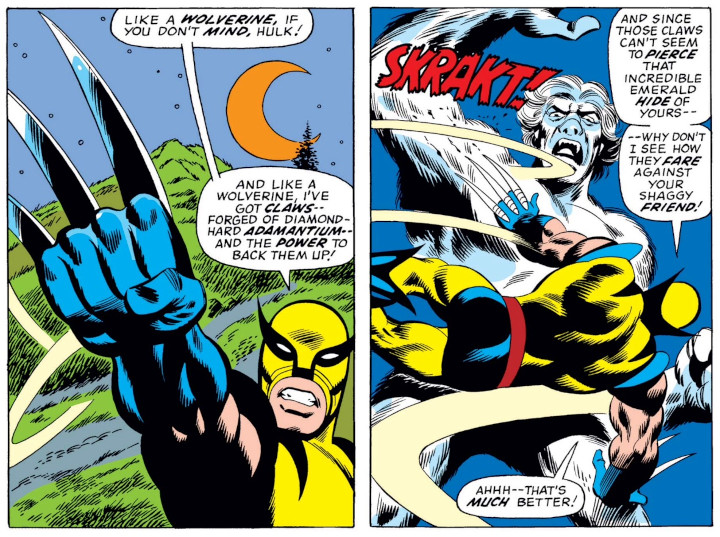
His next appearance, of course, will be in Giant-Size X-Men #1, and he’ll be looking a lot closer to the version we all know and love by that point. He got his mask figured out in the meantime, I guess.
Beast reappears in Avengers #136, but this entire issue is a flashback issue that retells his story from Amazing Adventures. If you’ve read those issues, you can skip this one entirely (reading orders from this period do seem to leave out Avengers #136).
Avengers #137 starts with the titular Avengers putting out a TV ad looking for new members. That doesn’t strike me as the most effective means of assembling a new squad of superheroes, but what do I know? In this case, it works, and the Avengers are joined by Wasp and Yellowjacket (Hank Pym’s current superhero identity), and, of course, the other Hank, Mr. McCoy himself.
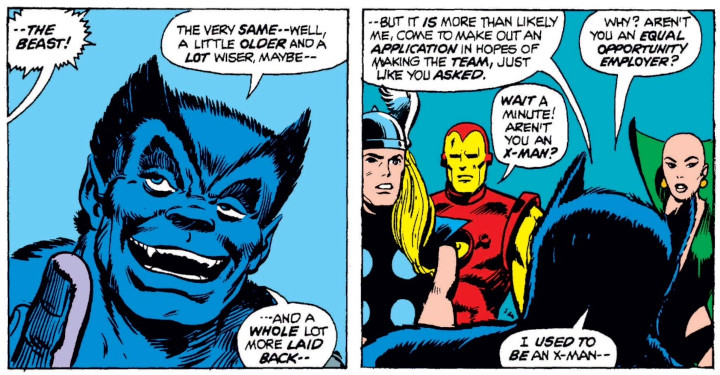
The Avengers basically invite people to try out for the team by meeting them at an abandoned stadium. This, of course, means that any villain who thirsts for revenge knows exactly where to find them, and the ads make it clear that the team is currently undersized. So of course there are villains who take advantage of this (not Magneto, though, because he’s a literal baby).
So a fight against the Stranger ensues (you might remember him from Uncanny X-Men #11), which has the Avengers leaping through hovering mines. Beast saves the day with his agility and beastlike eyesight, and he also spouts a very famous line.

In fact, Avengers #137 is the first time Hank says “Oh my stars and garters!” It’s possible that he snuck one in that I’ve forgotten, but this is the first time I recall seeing it. (Comic Book Resources has my back on this one, I might add.)
Wasp is critically injured in the fight, so the Avengers try to hunt down the Stranger in the following issues. We end up learning that the Stranger isn’t the Stranger at all, but Toad, who had secretly been in love with Scarlet Witch for years and became outraged that she’d married Vision. The Stranger thing was just a hallucinogenic projection.
I have to say, I’m a little disappointed in Toad’s arc. After all of the abuse he suffered at the hands of Magneto, I would have loved to see him have a redemptive arc. But that’s not in the cards for ol’ Toad (at least not yet — he does occasionally flirt with redemption here and there, but it never really takes).
A lot of reading orders for this period leave out Avengers #141, but that issue wraps up some dangling plot threads from the previous issues — most importantly for X-readers, the identity of the woman who’s been tracking Beast for the past few issues (it’s Patsy Waller — once Patsy Baxter — for those who are curious).
Then again, Avengers is heavily serialized by this point, and this particular Patsy Baxter storyline continues through issue #144, when she puts on the Cat’s discarded costume to become Hellcat.
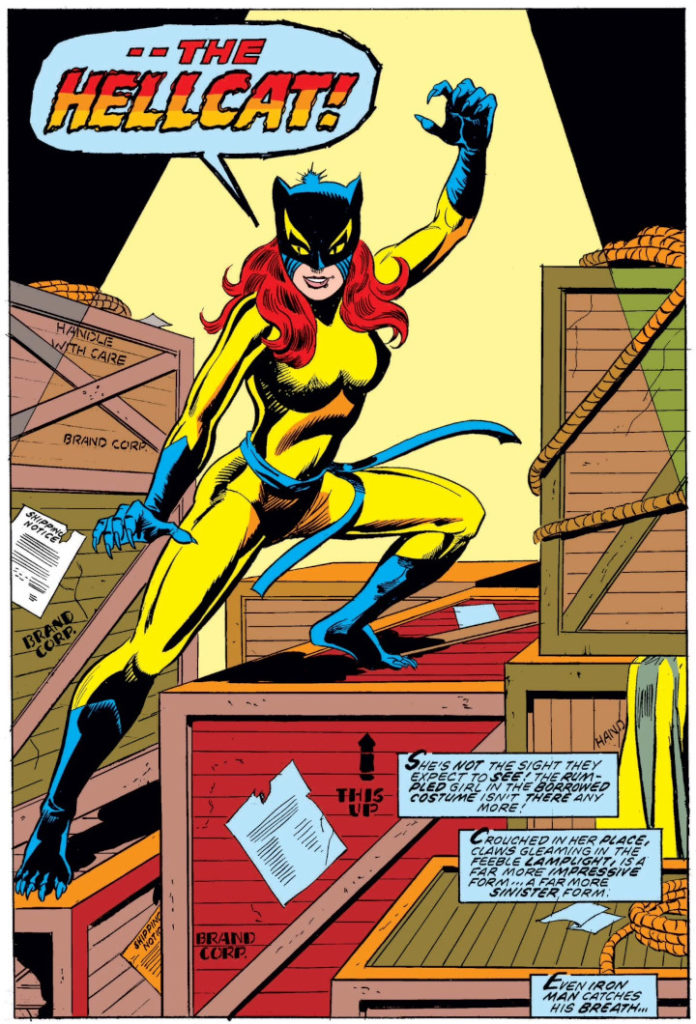
Meanwhile, there’s a time-travel story that sends half of the Avengers to the Wild West. It’s really hard to figure out where to quit reading, but I think there is some important stuff for Beast and Patsy up through issue #144. And even then, this particular adventure isn’t over yet. But if you really want to keep following Beast, he’s going to be an Avenger for a while now so you’ll want to keep reading Avengers. If you’re just interested in following the X-Men, you’ll want to jump ship somewhere between Avengers #140 and #144.
Of course, you will get a little more Beast action in Marvel Team-Up #38 for a rematch against the Griffin (from Amazing Adventures #15). Only now he has superhuman strength and the ability to command seagulls. His mind is also a fragile, fragile thing at this point.
Also, the A story in Giant-Size Fantastic Four #4 takes place after Giant-Size X-Men #1, but I tacked it onto this list since it’s not included in the Uncanny X-Men Vol. 1 omnibus (which will be my next X-Men review). This story is important, though, because it introduces Jamie Madrox, who will be a longtime staple of the X-books. The B story, however, is nonessential, as it just reprints Fantastic Four #28 (which should be on the reading list for the 1960s X-Men).
While this era is definitely an improvement over the 1960s, it’s harder to read because the X-Men’s storyline weaves between several other books, with no mainline series to keep it all grounded. I think the Beast storyline is worth reading, and even though the Harlan Ellison Hulk story isn’t necessary, it’s probably my favorite part of this whole batch of comics.
Do you really need to read this stuff?
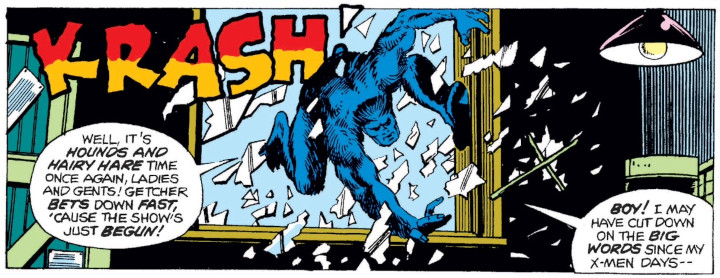
Basically, the important plot points in this run are Beast’s transformation, the baby-fication of the Brotherhood of Evil Mutants, Wolverine’s introduction, and Beast joining the Avengers. If you simply know that all of those things happened in this run, you’re more than ready to begin the Second Genesis era of the X-Men in Giant-Size X-Men #1.
If you’re interested in reading X-Men for the first time ever, the “Hidden Years” are mostly nonessential. You’ll want to get through it if you’re a completionist, but like I said earlier, you really just need to know a few basic things if you want to jump into the Claremont era (which is where X-Men really finds its voice).
What’s next?

Next up, I’m reading Giant-Size X-Men #1, then I’ll be diving into Chris Claremont’s extensive and incredible run. I’ve read a huge chunk of this run already (I’m a big fan of Claremont’s work in the 1980s in particular), but this will be my first time revisiting it since reading the 1960s and Hidden Years. And, if I make it all the way through, this will also be my first time reading Claremont’s run through to completion.
I do own a vast majority of Claremont’s X-Men in omnibus format, so I can put down Marvel Unlimited for a while (thank goodness). You can check out my review of the Uncanny X-Men Vol. 1 omnibus here.
From here on out, I’m going to review collected editions (mostly omnibuses, but there are some trade paperbacks in the mix to round things out). I’ll try to be clear about the reading order, since it can be a little confusing for new readers, especially once we get into the 1980s and crossovers start happening.